- You are here:
- Home »
- passing
Tag Archives for " passing "
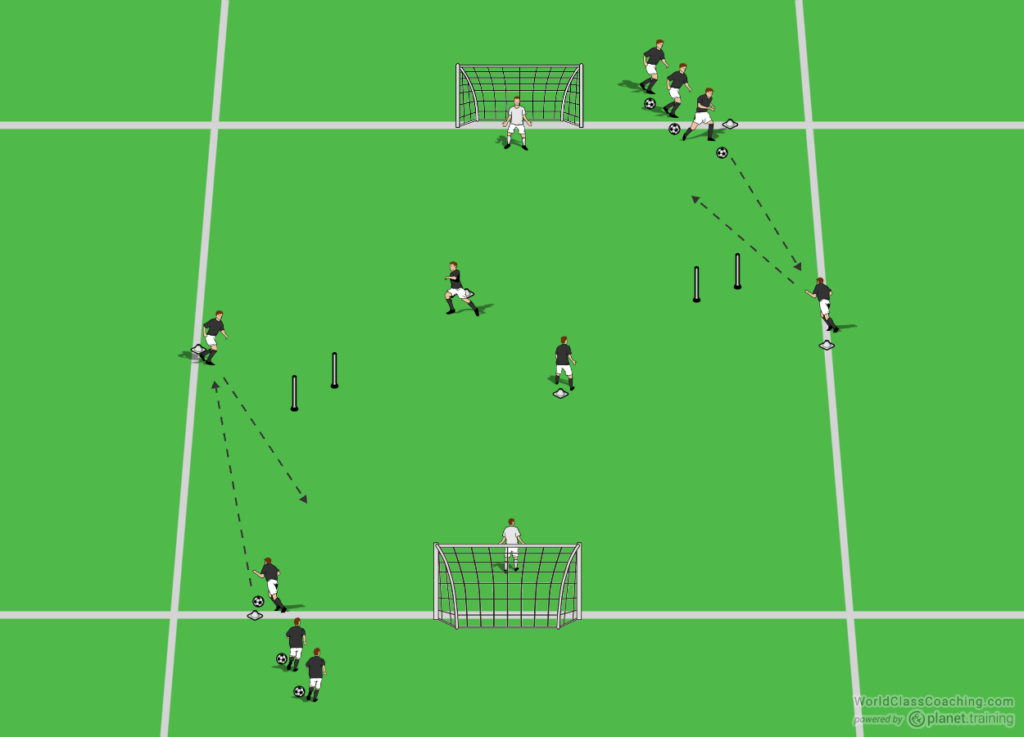
Shooting Combination with Starting Speed
By Alex Trukan
Shooting combination practice involves working on starting speed around the penalty box. This is important for players in order to gain advantage near the goal and be able to get to the ball before the defender. This in turn will help players to get into more goal scoring situations and eventually, score more goals. In this practice, the conditioning element is therefore linked to technical content of finishing as well as combination play in the final third.
Set up and directions
Organise two goals opposite to each other, 30 yards apart. Set up a cone next to the goal which will be starting point of the exercise. Organise further two cones (one on the angle to the left from the starting point and one on the angle to the right). There should be minimum 8-10 yards distance between the cones Set up a gate using two poles as shown on the diagram below. Divide the players into two groups. Set one player each on the cones in the middle and the rest of the players with one ball each on the starting cone. Goalkeepers should be set and ready in goals.
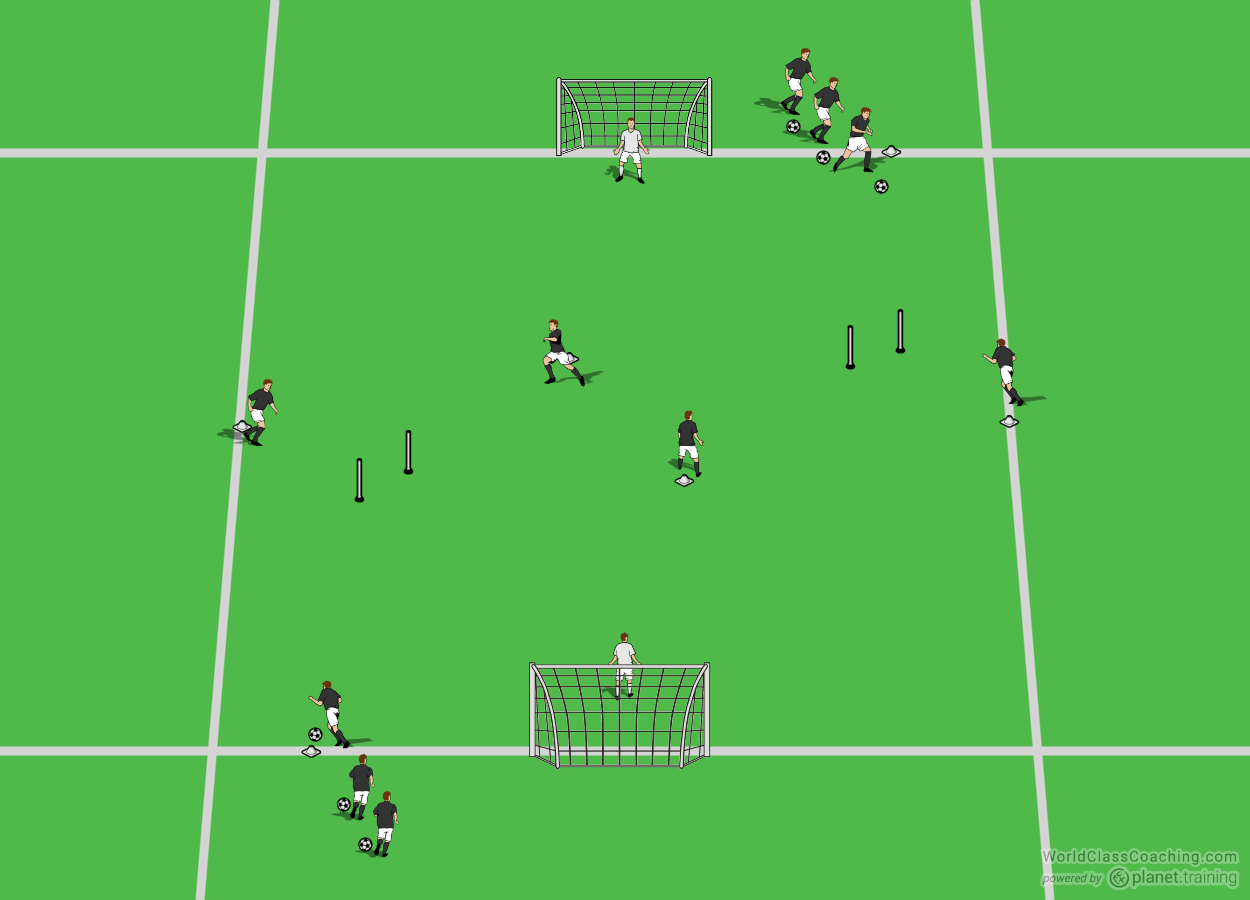
The practice starts with first player with the ball passing it to the player positioned on the cones to his left. The ball is then returned back on the angle using one touch. Both groups start at the same time.
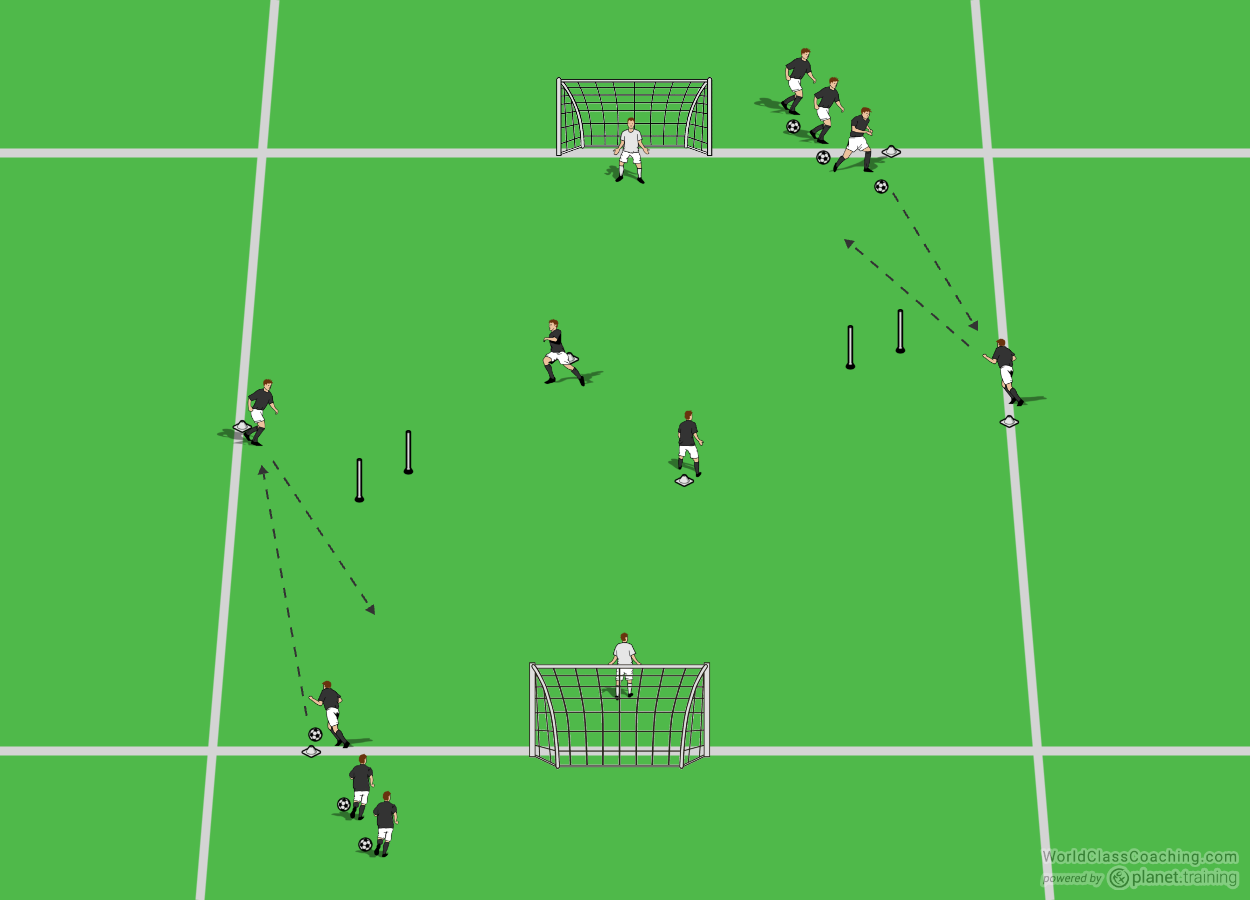
The player that started the practice passes the ball to the player positioned on the cone to his right. This pass is crucial for next sequence of the pattern and therefore should be played with high quality (allowing the receiver to play off one touch).
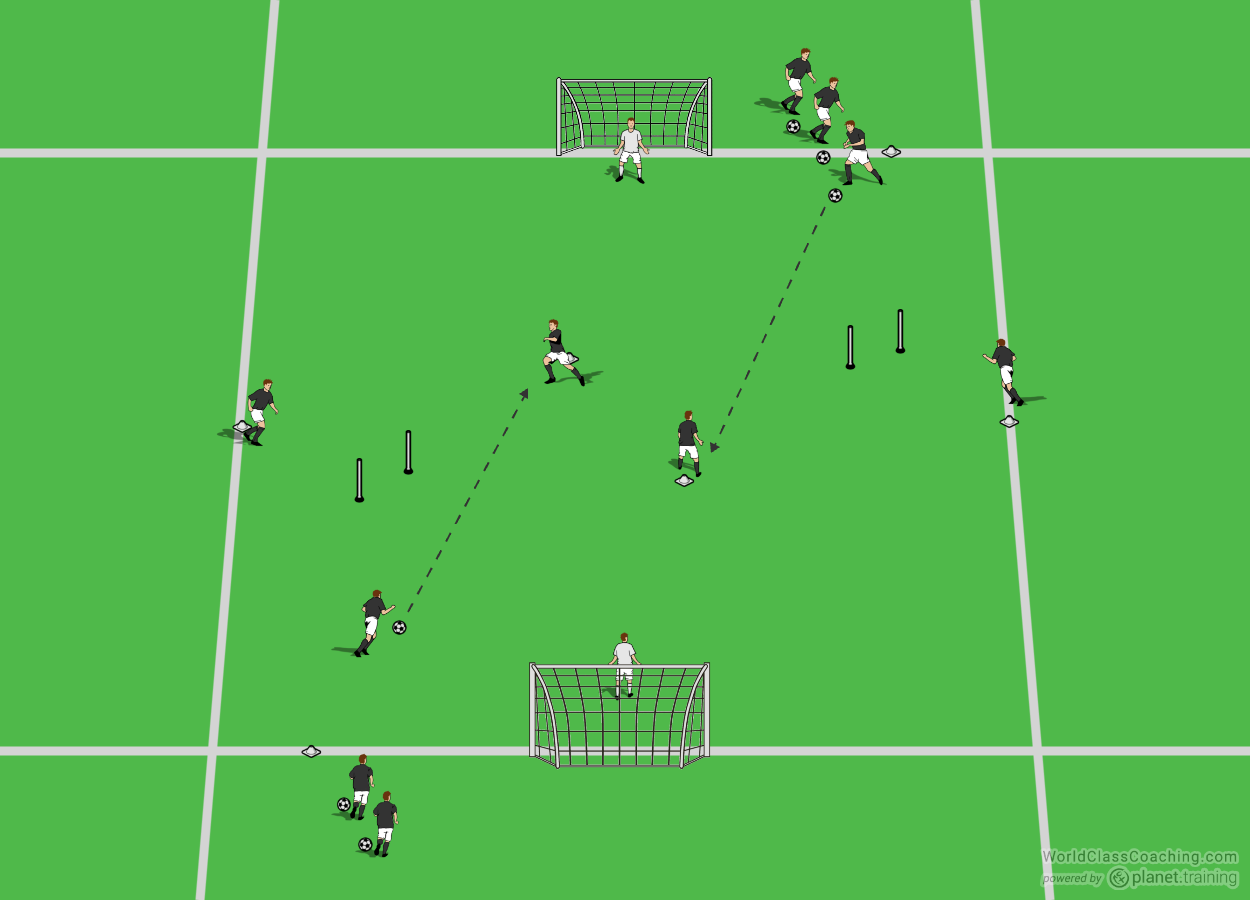
Following that, the receiver sets the ball on the angle. At the same time, the second player in a sequence makes a quick and sharp movement through the gate to then sprint onto the ball and finish in goal. This should be done on maximal speed. Players rotate clockwise (‘starting’ player-‘shooting’ player-‘setting’ player). As soon as one pattern finishes, the next one should start immediately to ensure appropriate work to rest ratios and flow of the practice.
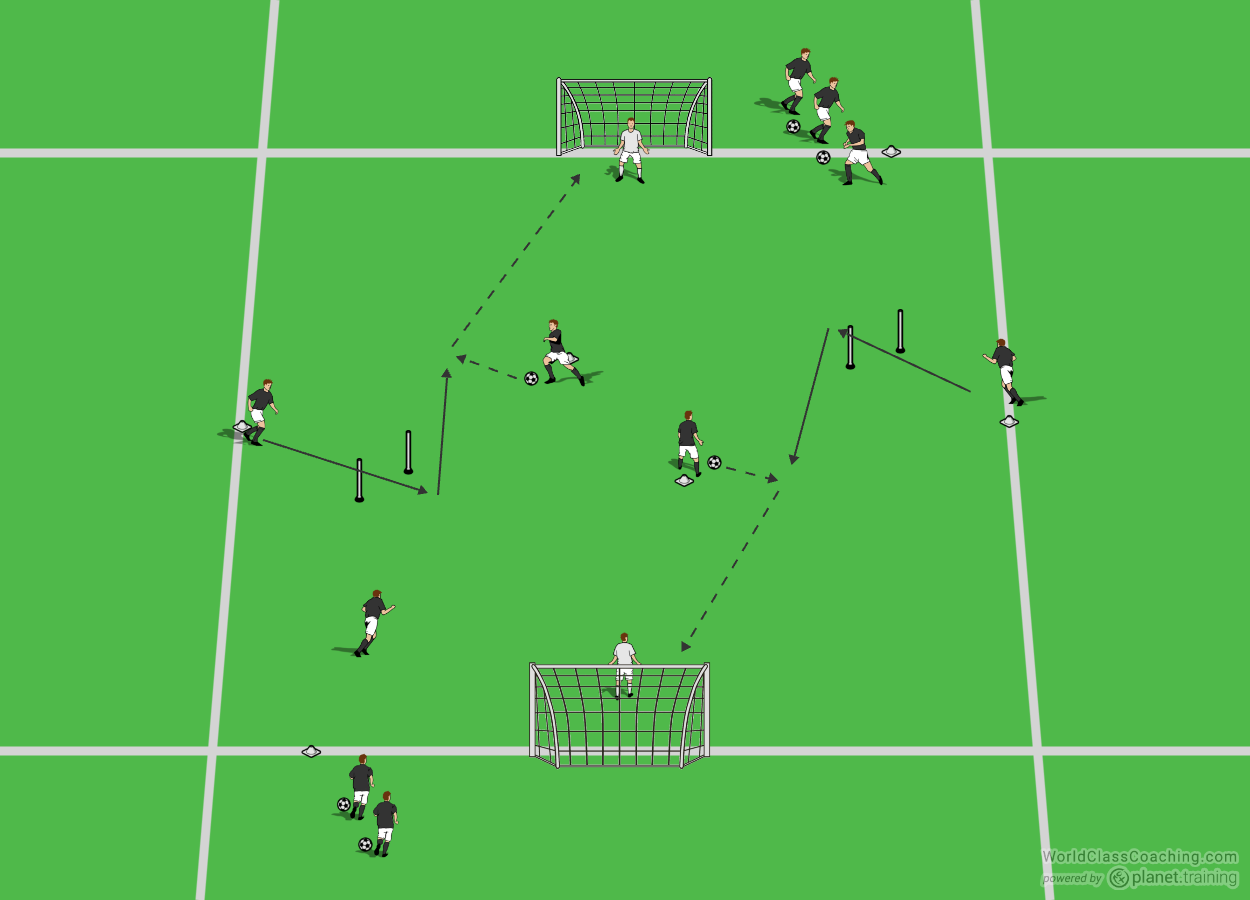
Timing
Each player should make 8-10 repetitions as a ‘shooting’ player. This should be done in 2-4 series with 30 second rest (working as a ‘starting’ or ‘setting’ player) between repetitions and 4 minutes between series.
Variations
- Increase/decrease distances between cones
- Passing off one/two touches
- ‘Shooting’ player passes directly to ‘setting’ player
By Alex Trukan, Development Coach, Nottingham Forest
@AlexTrukan

Crossing and Finishing Game
This is one of 28 articles and training sessions on conditioning and other topics that will be published this month in the Training Center. Click Here to learn how you can receive access to all of them.
By Alex Trukan
This practice is designed to improve players’ ability to recover between high intensity actions in a most efficient way. This will allow players to sustain the quality (speed and strength) of their actions for longer throughout the game. These physical outcomes are achieved in a highly technically demanding game containing a lot of crossing and finishing. Small amount of players on each side ensure high intensity and engagement of the players.
Set Up and Directions
Organise a pitch of 25 x 20 yards with three zones – two wide zones (5 yards wide each) and central zone (15 yards wide). Set up two goals on the opposite ends as shown on the diagram below. Divide the group into two teams of three. Set the goalkeepers in goals. Prepare a sufficient supply of balls to ensure flow of the practice.
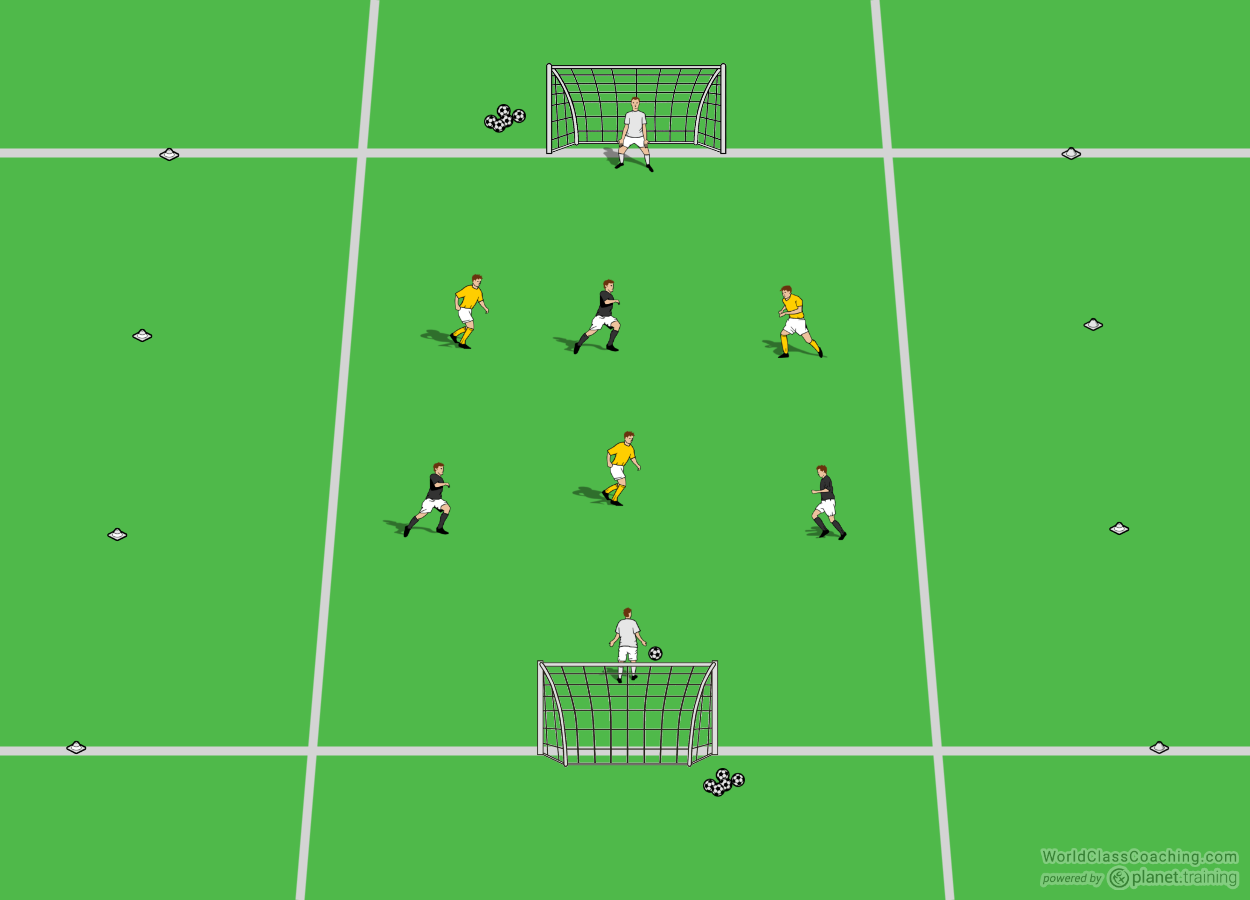
The practice starts with a goalkeeper passing to any of the teams. After this, the aim of the team in possession is to make 3 consecutive passes. This should be completed in the middle part of the pitch.
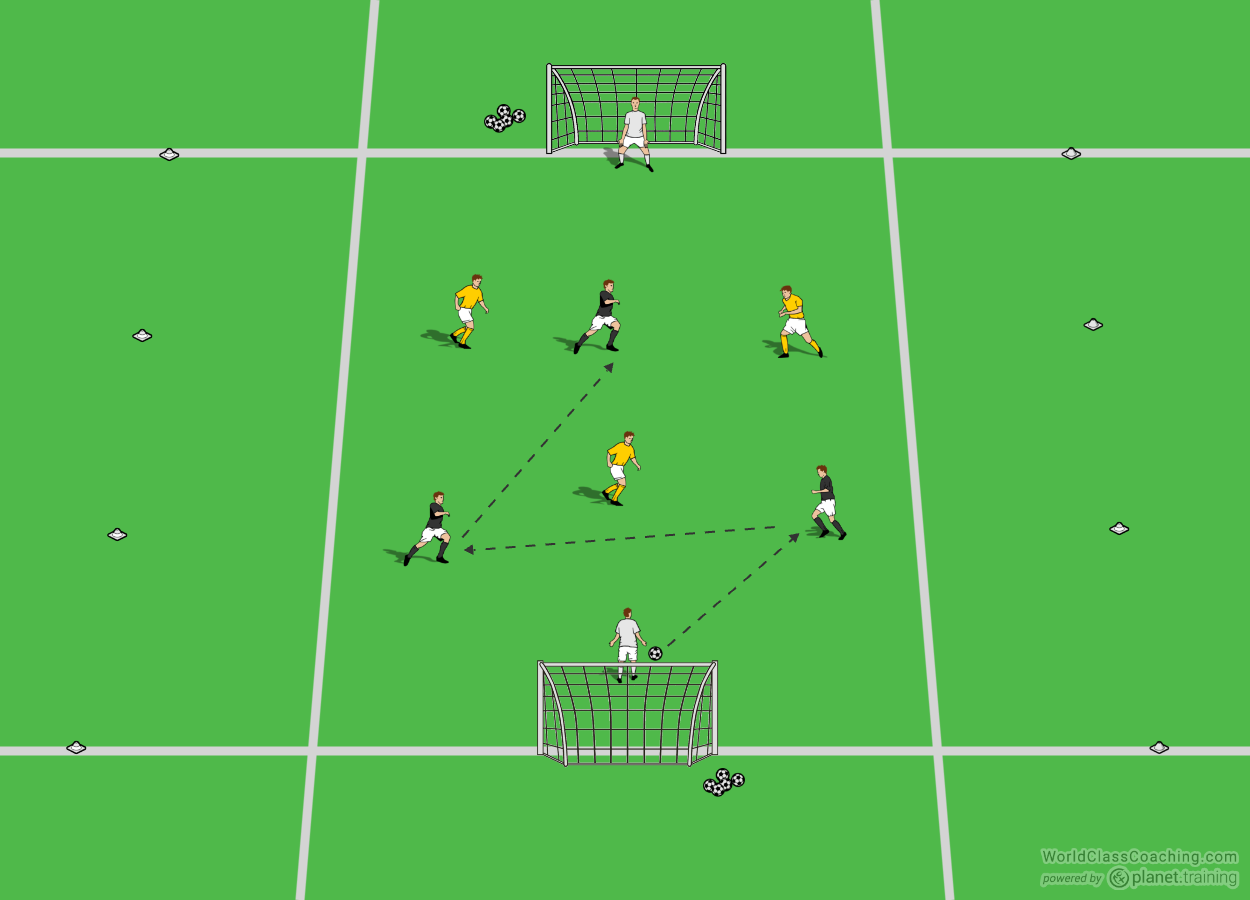
As soon as the 3 passes are made, the ball can be played into one of the wide areas to the player making a movement there (max. two attacking players can be in one wide area). Only one defender can tackle in wide area.
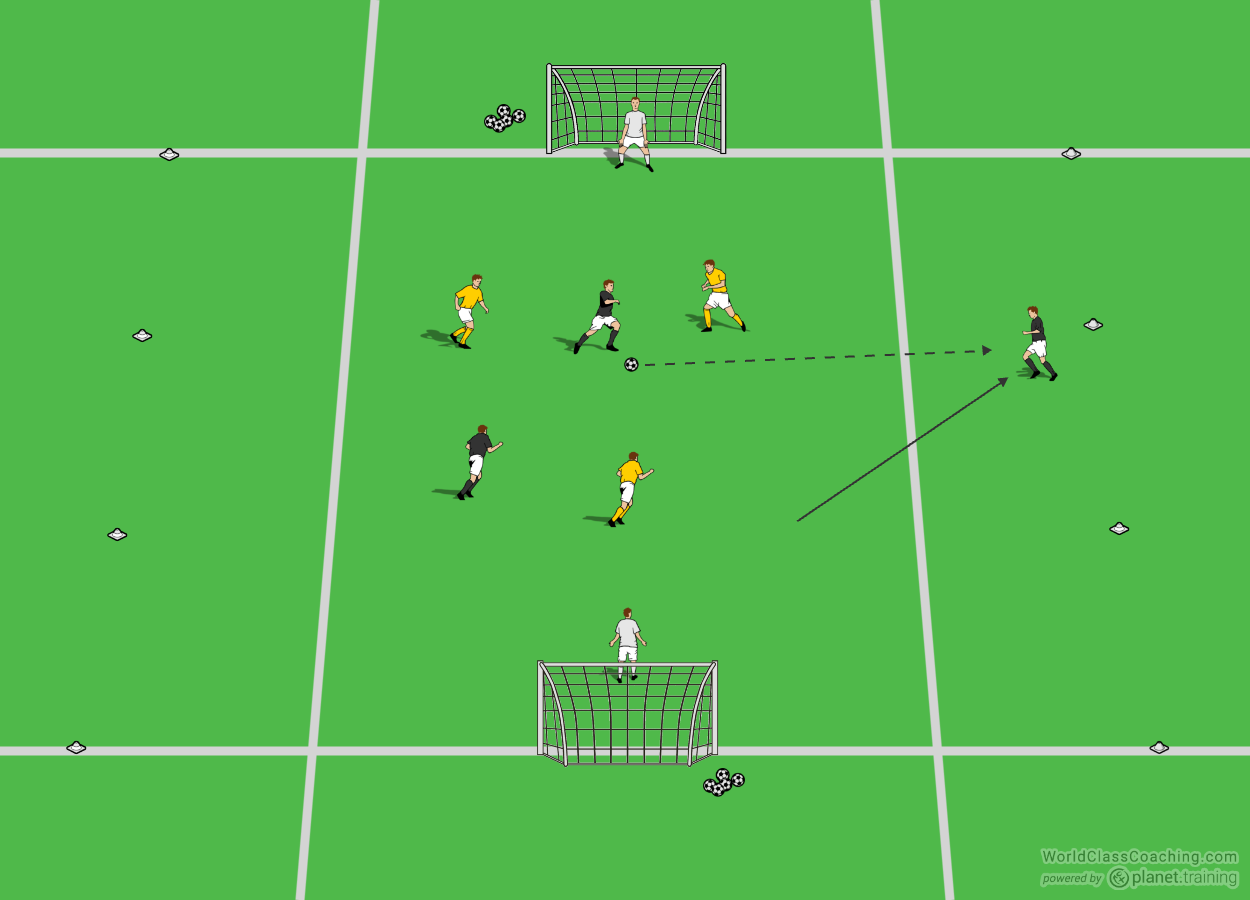
The attacking team can have only three entries into wide areas per attack what will encourage quicker turn overs of possession and more crosses. The ball can be delivered both aerially and on the ground.
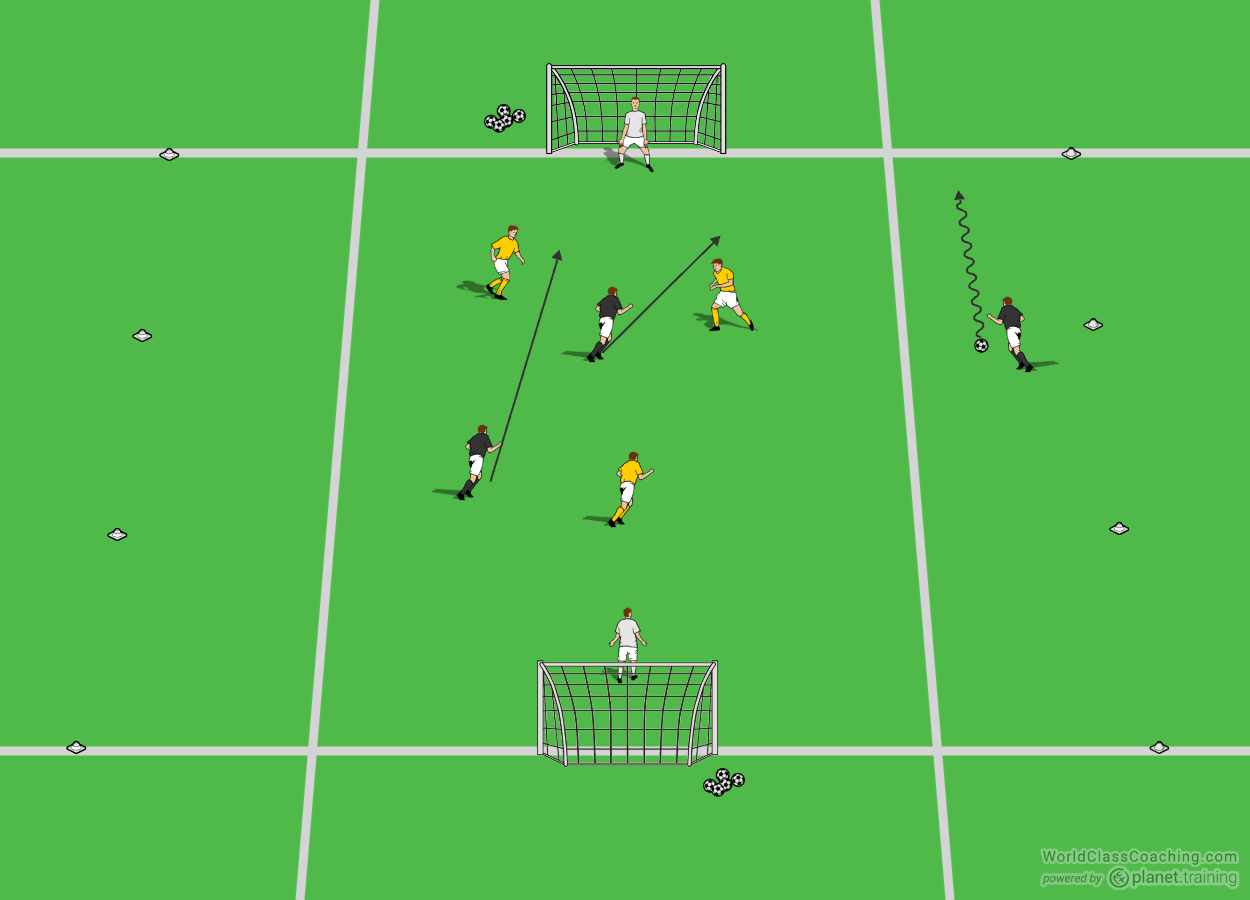
As the wide player is about to deliver the ball, the other players should look to make explosive forward movements to finish. If the ball goes out for a corner, it is restarted from the opposite goalkeeper (no corners).
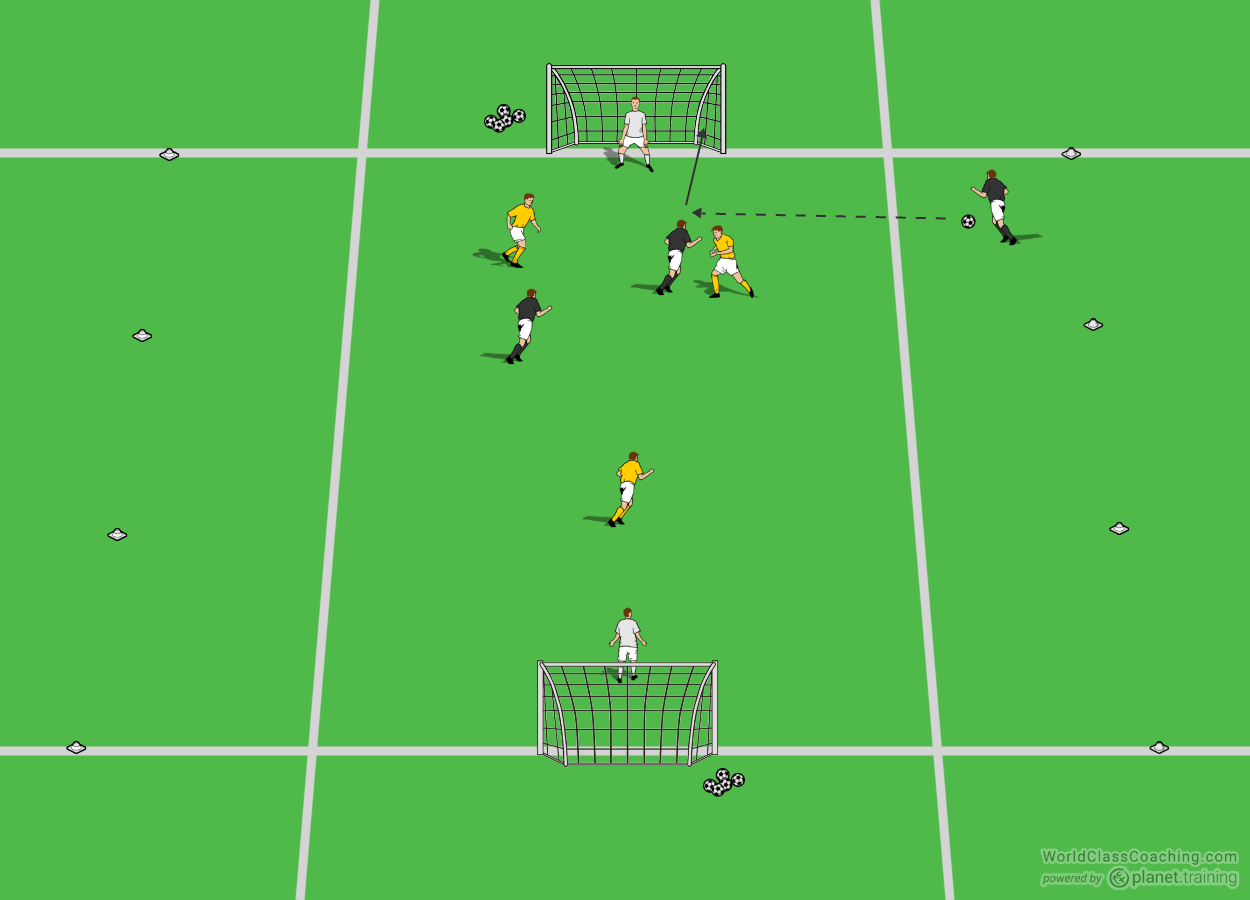
Timing
The practice should last 1-3 minutes and be repeated 6-10 times in 2 series. Rest between repetitions should be 1-3 minutes and between series, 4 minutes.
Variations
- 4v4/3v3+1
- Max. 2 entries into wide areas before a finish
- Min. 2 passes before the ball can be played wide
By Alex Trukan, Development Coach, Nottingham Forest
@AlexTrukan

Rondos with Explosive Power
By Alex Trukan
This practice is designed to improve players’ ability to recover between high intensity actions in a most efficient way. This will allow players to sustain the quality (speed and strength) of their actions for longer throughout the game. These physical outcomes are achieved in a highly technically demanding game containing a lot of crossing and finishing. Small amount of players on each side ensure high intensity and engagement of the players.
Set Up and Directions
Organise a pitch of 25 x 20 yards with three zones – two wide zones (5 yards wide each) and central zone (15 yards wide). Set up two goals on the opposite ends as shown on the diagram below. Divide the group into two teams of three. Set the goalkeepers in goals. Prepare a sufficient supply of balls to ensure flow of the practice.

The practice starts with a goalkeeper passing to any of the teams. After this, the aim of the team in possession is to make 3 consecutive passes. This should be completed in the middle part of the pitch.

As soon as the 3 passes are made, the ball can be played into one of the wide areas to the player making a movement there (max. two attacking players can be in one wide area). Only one defender can tackle in wide area.

The attacking team can have only three entries into wide areas per attack what will encourage quicker turn overs of possession and more crosses. The ball can be delivered both aerially and on the ground.

As the wide player is about to deliver the ball, the other players should look to make explosive forward movements to finish. If the ball goes out for a corner, it is restarted from the opposite goalkeeper (no corners).

Timing
The practice should last 1-3 minutes and be repeated 6-10 times in 2 series. Rest between repetitions should be 1-3 minutes and between series, 4 minutes.
Variations
- 4v4/3v3+1
- Max. 2 entries into wide areas before a finish
- Min. 2 passes before the ball can be played wide
By Alex Trukan, Development Coach, Nottingham Forest
@AlexTrukan

Possession Game with Finishing
By Alex Trukan
This practice has multiple challenges in all facets of the game. Firstly, from the conditioning point of view, it develops explosiveness and power. That is especially required when breaking through defences and around the opposition penalty box. From the technical perspective, it includes elements of passing, combination play as well as finishing. It also challenges players’ decision making on when to speed up play and try to score. Having an end product (shot on goal) makes it engaging and enjoyable for players. The practice is designed for intermediate and advanced players.
Set up and directions
Organise a 20 x 30 yards rectangle. Place two goals on the opposite ends, 15 yards away from the playing area. Divide the players into three teams of three. Two teams are positioned in the middle of the playing area and compete against each other. Third team is neutral, two players from that team are outside the area and one in the middle as shown on the diagram below. The neutral team plays with whichever team is in possession. Prepare a sufficient supply of balls.
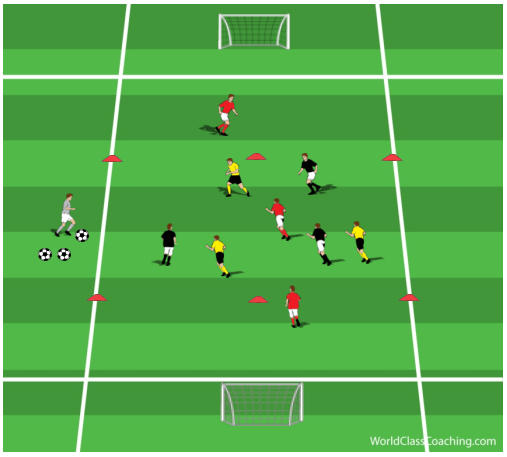
The practice starts from the coach playing the ball to one of the attacking teams (not neutral). Which team starts with the ball can be adapted to the group needs and objectives of the session.
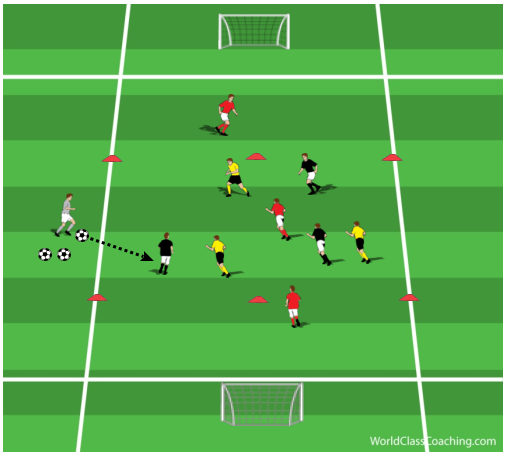
The team is possession then tries to make three passes before breaking through. The second team tries to get in possession with the same objective of making three passes. Neutral players support the team in possession of the ball.
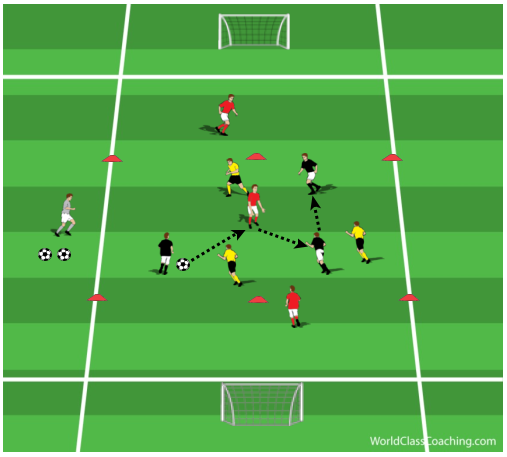
After the team makes three passes, they can play to any of the outside neutral players and break through to finish on goal. Minimum two players have to break through out of the square. The player that played the ball to the neutral player can’t be the one that finishes (forces third man run). The defending team can send out as many players as they want to stop the other team scoring. After the shot is made the practice is restarted from the coach playing the ball to the second team.
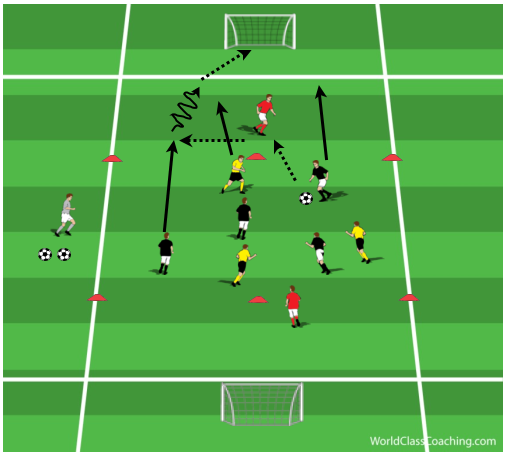
Timing
Both teams compete to ‘break’ 10 times. Every ‘break’ should last no longer than 3 seconds. That should be repeated in 2-4 series with 4 minutes break in between them.
Variations
- 4v4 in the middle
- 2 passes before the ‘break’
- Increase/decrease the distance between the playing area and goals
By Alex Trukan, Development Coach, Nottingham Forest
@AlexTrukan
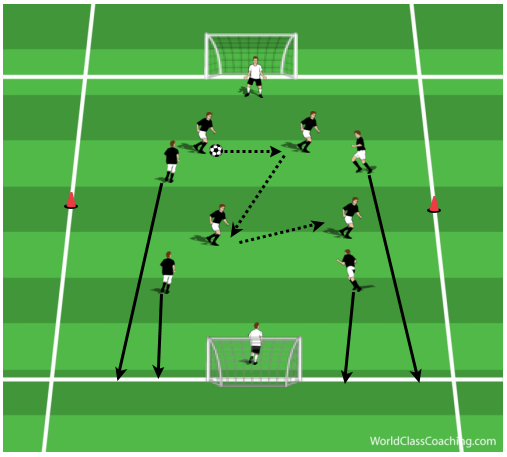
Small Sided Game to Improve Anaerobic Endurance
By Alex Trukan
The presented game is aimed at improving players’ ability to produce more high intensity actions throughout the game. This is achieved in a conditioned game which has elements of defensive transition, combination play as well as recovery runs. The organisation of this practices challenges players to react quickly when losing possession as well as combine play to attack upon winning it. This small sided game has some major tactical trade-offs, however the main area of focus is the physical corner. This practice is well suited for intermediate and advanced players.
Set-Up and Directions
Organise 30 x 40 yards pitch with two goals on the opposite ends. Mark out half way line. Divide the players into two teams of 4. Set goalkeepers in goals. The area size may be bigger if more players are involved. Prepare supply of balls.
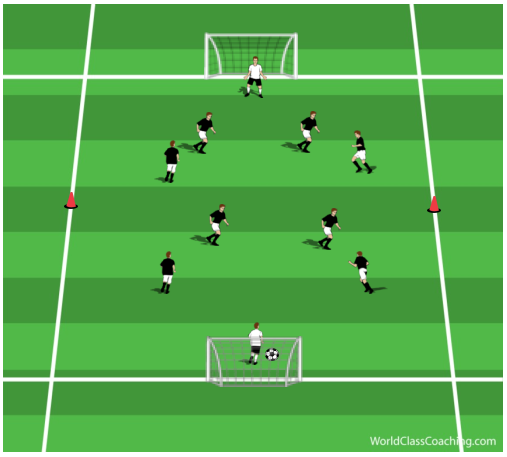
The game starts with a goalkeeper playing out to one of the players from his team. The aim of the team in possession is to score in the opposition goal. Normal rules of football apply.
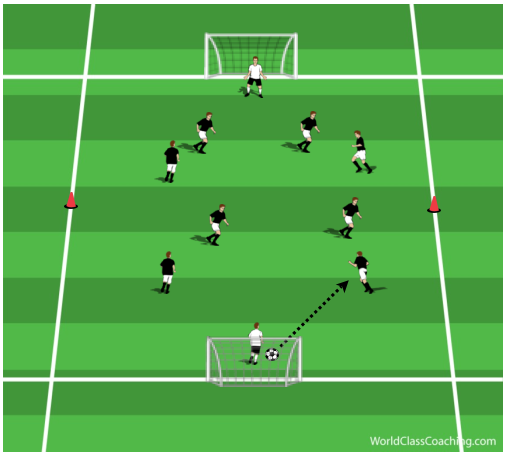
The condition of the game focuses on the moment of losing possession. If the attacking team loses the ball whether it’s after tackle or interception, all of the players from that team have to touch the line by their own goal before they can defend.
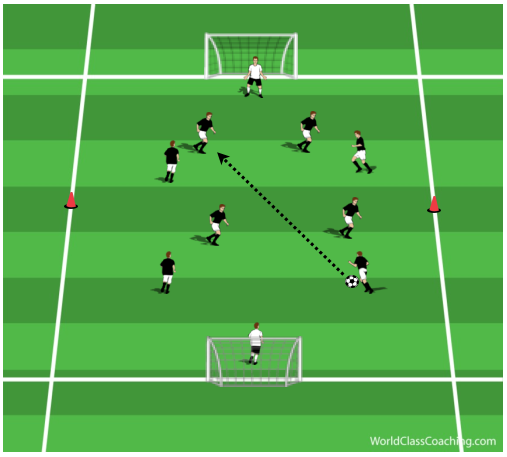
As we can see below, the reaction of the team that lost possession is to make a sprint towards own end line. The team that gained possession in turn, has to make 3 passes before they can attack and shoot.

The challenge for the defending team is to apply pressure on the attackers as soon as possible to prevent shots on target and their progression forwards.
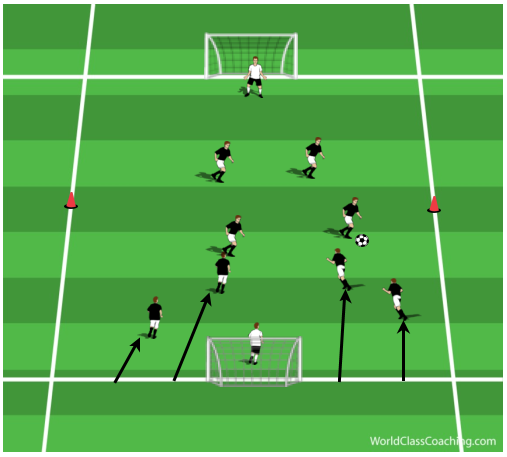
Timing
The game should be played 3 minutes and repeated 6-10 times in 2 series. The rest period between repetitions should be 1- 3 mins and between series – 4 minutes.
Variations
- 4 v 4/6 v 6
- Team that lost possession has to touch specific cone/line set by coach
- Team that won possession has to make 5 passes before making an attack
By Alex Trukan, Development Coach, Nottingham Forest
@AlexTrukan
